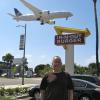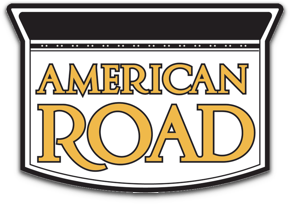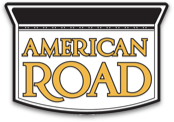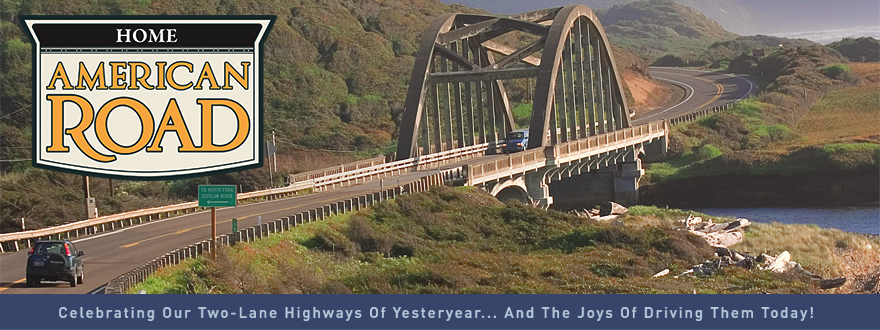-
Posts
328 -
Joined
-
Last visited
-
Days Won
4
Content Type
Profiles
Forums
Gallery
Blogs
Calendar
Everything posted by mga707
-

Little America, Wyoming
mga707 replied to Chris Rowland's topic in Lincoln Highway / U.S. 30 / U.S. 50
The '64 or '65 Plymouth Barracuda at lower right is the newest vehicle I can definitely ID. -

The Vigilante Trail
mga707 replied to Road Warrior's topic in Yellowstone Trail / National Parks Highway
Excellent--love this!- 1 reply
-
- 1
-

-

Historic US 80 in Arizona
mga707 replied to Michael Ballard's topic in Old Spanish Trail / U.S. 80 / U.S. 90
Historic 80 signs are also on what is now SR 80 from Benson down through Tombstone/Bisbee/Douglas and over to the NM border. Also in the Yuma area, if memory serves. Minor correction to the above post: The State Route from Florence Junction to Oracle Junction is 79, not 77. 77 picks up old 80/89 at Oracle Junction and continues into Tucson. The historic 80 signage continues to the Tucson city limits. -

Mystery Coupe in Echo Canyon
mga707 replied to roadhound's topic in Lincoln Highway / U.S. 30 / U.S. 50
-

Mystery Coupe in Echo Canyon
mga707 replied to roadhound's topic in Lincoln Highway / U.S. 30 / U.S. 50
Correct. Most '46-'47, and many '48 models as well, were '41-'42 bodies with 'freshened' trim. It was a unique seller's market given the pent-up demand caused by the lack of new car production during the war years, so anything that was built sold, usually at or above above sticker price (lots of 'under the table' payments to dealers to guarantee a spot on the delivery list!). The 'independent' manufacturers came out with 'all-new' postwar cars first, starting with Studebaker in mid-1946 with their Raymond Loewy-designed 'aero-look' 1947 models. Hudson, Nash, and Packard all followed at some point during the 1947 model year. The 'big 3' were slower, with both GM and Ford holding off until the 1948 model year to bring out all-new top end brands (Lincoln, Cadillac, and some Buick and Oldsmobile models) and until 1949 for their 'bread and butter' lower-priced marques. Chrysler Corp. was even slower, keeping their pre-war bodies through early 1949 and replacing them with a 'second series' of new 1949 designs in mid-model year. -

Mystery Coupe in Echo Canyon
mga707 replied to roadhound's topic in Lincoln Highway / U.S. 30 / U.S. 50
Looked through my 'Encyclopedia of American Cars 1930-1980' to no avail. Will go out on a limb and say it looks like either immediate pre-war (1941-42) or just after (1946-47) to me. -
The 'Reader's Digest' short version is that commercial radio stations have contracts with the two main music publishing organizations, BMI (Broadcast Music International) and ASCAP (American Society of Composers, Authors, and Publishers) whom they pay. The two publishing organizations then distribute songwriting royalties to their respective songwriters.
-
Thank you for that update--really disappointing that the signs were stolen, one would assume merely for the value of the metal. The Next Exit article is fascinating!
-
Oh, and to update another facet of this 10-year-old thread, I still have the '05 Vibe. 187,000 miles and still zero major problems. Did have the infamous Tanaka airbag recall, and then a recall on the recall. Did not drive it on this particular trip, though, but it is hitting the road for San Diego in less than a month. The '99 Miata was not so lucky, took a check from insurance for it in '16 following a chain-reaction crash on I-10 that would've cost about 7K to repair.
-
Revisited the 1927 bridge yesterday, and drove the nearly the entire stretch of Old US 80 from the Salome Highway down to Gila Bend. Some changes in the last 10 years: The bridge now has height 'sizer' barriers at each end--wonder if there was an 'oops' accident? Also, at the east end of the bridge there is now a parking area and raised viewpoint, constructed in 2012 according to the sign. It looks like there are places for interpretive signs in two places, but they have not as of yet been installed. The view area does have a steel 'knuckle' of the type used in the bridge--neat touch. Here's some pictures:
-

Fairbank AZ roadside store restored
mga707 replied to mga707's topic in Other Roadside Business / Attractions
Dave, I just looked on Google Earth at the Fairbank area and saw the structure you mention above. That is a horse corral, presently in use. Horseback riding in the National Conservation Area is popular, and there are many trails. If you follow the old rail bed south from the Highway 82 a short ways you can see the foundation remains of the old rail depot. -

Fairbank AZ roadside store restored
mga707 replied to mga707's topic in Other Roadside Business / Attractions
Not sure about the foundation you mention. The old two-story railroad station, which was demolished after passenger service ended in the mid-1960s, was located farther south along the old rail bed, so it's probably not that. I'm going to have to check Google Earth as well--love looking at their aerials of abandoned places I've visited. Yes, the BLM had done a wonderful job of historical preservation in a couple of National Conservation Areas not too far from my home in Tucson. Fairbank is located within the San Pedro Riparian NCA, and they have also beautifully restored the Empire Ranch buildings, including the main ranch house that dates to the 1870s, in the Las Cienegas NCA, which is located just east of State Route 83 near Sonoita. Here are two more shots from Fairbank, of the interior and exterior of the old three-room schoolhouse that is now the Visitor Center. The school closed in the mid-1940s, which is when the town declined to just a few dozen residents. The desks came from the old school in Tombstone. The schoolhouse is to the left of the store in the above pictures, and the former teacher's house is next to it. Unfortunately, due to safety concerns, the school is the only one of the three buildings open to the public, although the house can be looked into through the windows. Fairbank is one of those rare 'ghost towns' that are located right along a paved State highway. -
The Fairbank Commercial Company store, gas station, and post office sits along one of Arizona's original State Highways, SR 82, a few miles NW of Tombstone and right by the San Pedro River. Fairbank got it's start in the late 1800s as the rail stop for Tombstone. The trains stopped running in the 1960s, but the store remained open into the early 1970s. By the early 1980s it was in very bad shape and in danger of collapsing. Luckily, the BLM has restored the building and the entire Fairbank townsite around it. Original plan was to put a visitor center in the old store but the building was just too deteriorated so the center went into the three-room schoolhouse next door. It is a gem! Here's a photo of the old roadside store from last month, and one from 1982 for comparison. State Route 82 is just to the right in both shots.
-
KFI Los Angeles at 640 on the AM dial was another 50,000-watt clear channel station, so I'm sure you were able to hear them at night as well. As well as 1520 KOMA in OKC, who came in all over the western US at night. But I digress.. Got a sample of those bygone days last summer in Raton NM. All of the eight or so chain motels were full due to forest fire evacuations, so we would up at a place I believe was called the Maverick Motel. An absolute time warp 'Mom and Pop' place straight out of the 1950s. Room (one of 12) was clean and quiet, but definitely 'no frills'. Even had one of those old-fashioned tiny free-standing bathroom sinks. And a tiny stall shower! At least the AC was good and not too noisy. Mattresses were thin but not too bad. We slept well!
-
Congratulations on having your photo honored with a stamp!
-
Not to minimize your rather harrowing experience with 'La Migra', but the road you were following through Dome Valley was not actually the old Bankhead Highway/Broadway Of America/Old Spanish Trail/US 80. There is doubt whether the road through the valley ever actually was signed as '80', as the 'new' route through Telegraph Pass, which is still the route of eastbound I-8, was completed and opened for traffic in 1927. Anyway, from your description I gather that you were traveling on the paved, 'stairstep' road through the valley that runs north and east of the Gila River bed, following section lines. This road is newer than the actual old highway, which has never been paved and runs very close to the railroad tracks that are south and west of the normally dry Gila bed. In his exhaustively-researched 2009 book, "Drive the Broadway Of America--the U.S. 80 and Bankhead Highways Across the American Southwest", author Jeff Jensen gives a mile-by-mile account of this early alignment, and strongly recommends attempting to drive it only with a 4WD vehicle, as parts are extremely sandy and rough. This original alignment comes out to what is now US 95 about a mile south of the historic McPhail bridge that you mention above. Ironically, had you taken this old but rough original alignment, you probably would not have encountered any BP vehicles at all--but you may very well have gotten stuck in a sandy, dry washbed! For what it's worth, I was traveling the opposite direction on I-8 the following day, heading to Encinitas CA from Tucson, and wishing I had the extra time to explore some of the old sections of US 80!
-
For me, Chicago to OKC is a bit too long for one day--I'd stop in Tulsa. And as much as I enjoy Flagstaff, I'd stop in Winslow instead and spend the night at the classic La Posada Fred Harvey railroad hotel there.
-
David Lynch's "Lost Highway", 1997.
-
Thank you, Dave! Did not see any peacocks. Just one resident dog and two resident cats. No ghost cats, although there is supposedly one 'haunting' the hotel, along with an adult male ghost and a juvenile female ghost. I slept like a log, but my travel companion did not! After I got home i learned that the Amargosa is supposedly one of the 'most haunted' hotels in the Us, for what that's worth. I'm not sure how long it has been since the Hotel re-opened, but I hope the owners can make a success of it. They were nearly full the two nights we were there, with many foreign tourists. About half of the building has not been renovated, as the 18 rooms open all have private baths and the closed-off rooms do not. Our tour of the Opera House ($5 donation) was well worth it. It is amazing inside, and we were treated to a two-song piano concert by a concert pianist who happened to be visiting that day. He used to play for Marta there when she did her shows, which ended in 2012. I would love to revisit in the future.
-
It definitely is! And from an old roads perspective, the drive south from DV Jct. to the 'big town' of Shoshone (pop. 31 per the town sign) is also interesting, as one has the abandoned railroad track bed on the left (east) side of CA 127 and and recurring bits of the old, narrower road alignment to the right. If lucky one might see wild mustangs!




